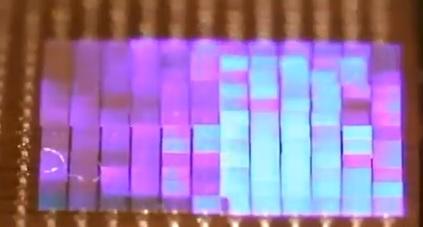Illinois researchers develop new surface design inspired by snake skin

Seok Kim Lab develops new surface design inspired by snake skin. Credit: University of Illinois Department of Mechanical Science and Engineering
Their work, “Magnetically Responsive Elastomer-Silicon Hybrid Surfaces for Fluid and Light Manipulation,” was recently featured on the cover of Small.
Their new surface design features rigid scales assembled into soft, ferromagnetic micropillars on a flexible substrate in a predesigned manner by transfer printing-based deterministic assembly. The nanostructured silicon scales on the magnetically responsive elastomer micropillar array enables fluid and light manipulation.
The functional properties of the surface are dictated by the scales' patterns, while the micropillar array is magnetically actuated with large-range, instantaneous, and reversible deformation.
Kim and his researchers were able to design, characterize, and analyze a wide range of functions, such as tunable wetting, droplet manipulation, tunable optical transmission, and structural coloration, by incorporating a wide range of scales–bare silicon, black silicon, and photonic crystal scales–in both in-plane and out-of-plane configurations.
Magnetically response materials like soft elastomers loaded with magnetic particles, are desirable for their real-time manipulation of fluid, light, solid particles, and living cells – thanks to their instantaneous structural tenability under a magnetic field. However, due to the fabrication process, most existing surfaces of this kind are limited in their functional ability.
Compared with common responsive surface with simple design (the magnetic micropillar array), the surface developed in our work not only has enhanced performance in directional liquid spreading and optical transmission tuning, but also enables novel functions such as droplet manipulation and dynamic structural coloration,” said Yang, PhD candidate and first author of the study.
Their results suggest a versatile platform for both fluid and light manipulations at both the micro and macroscale. Potential applications can be found in digital microfluidics, biomedical devices, virtual blinds, camouflage surfaces, and micromirror arrays. Further work could also result in more biomimetic functionalities such as robotic locomotion, swimming, self-cleaning, and solid object manipulation. Their design could also be integrated with active devices such as solar cells, light emitting diodes, and lasers as scales to form novel flexible optoelectronics.
Kim is a leading scientist in advanced transfer printing and transfer printing-based microassembly.
Media Contact
All latest news from the category: Materials Sciences
Materials management deals with the research, development, manufacturing and processing of raw and industrial materials. Key aspects here are biological and medical issues, which play an increasingly important role in this field.
innovations-report offers in-depth articles related to the development and application of materials and the structure and properties of new materials.
Newest articles

Properties of new materials for microchips
… can now be measured well. Reseachers of Delft University of Technology demonstrated measuring performance properties of ultrathin silicon membranes. Making ever smaller and more powerful chips requires new ultrathin…

Floating solar’s potential
… to support sustainable development by addressing climate, water, and energy goals holistically. A new study published this week in Nature Energy raises the potential for floating solar photovoltaics (FPV)…

Skyrmions move at record speeds
… a step towards the computing of the future. An international research team led by scientists from the CNRS1 has discovered that the magnetic nanobubbles2 known as skyrmions can be…





















